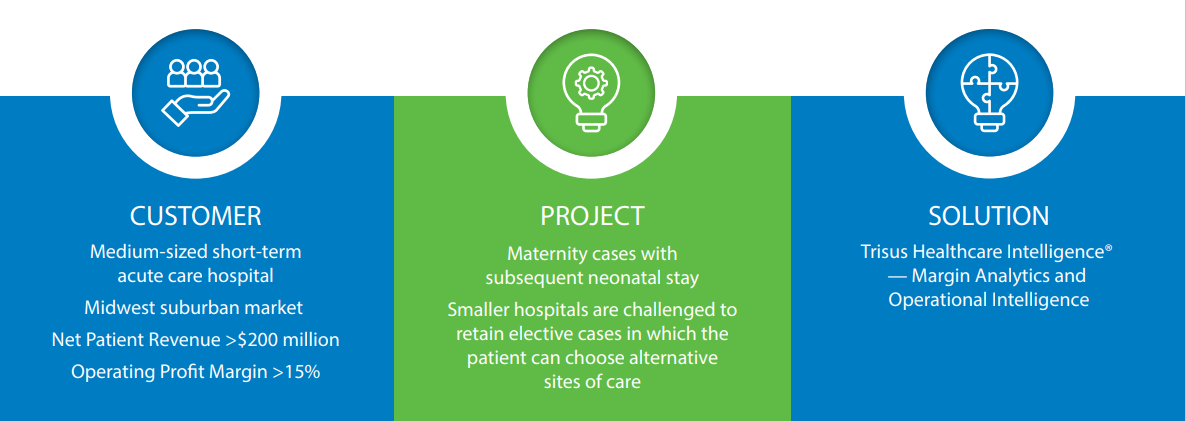As the healthcare industry embraces value-based economics, outcomes are increasingly evaluated on both cost and the quality of care provided to your patient population. The importance of understanding cost across the hospital, by department, and by medical condition is essential to discovering possibilities for cost-saving, quality improvement opportunities.
Trisus® Healthcare Intelligence sheds light on how individual process variations made during the continuum of care produce different profit margins by medical condition, allowing you to see operational and financial data at a patient level, the way a physician approaches care delivery. The power in that data is the ability to use these insights to drive clinical process improvements that not only maximize clinical outcomes, but also financial performance – providing margin for your mission.


Objectives
- Analyze DRGs for obstetrics and neonatal services to identify a sample with significant margin loss per case
- Within the sample, identify process improvement projects to impact quality of care and financial metrics
- Provide margin projection to remain competitive and viable within the local market
Key Data Challenges
Diagnosis Related Group (DRG) reimbursement – fixed payments for care provided for a specified medical condition – limits the ability of healthcare providers to complete crucial steps to achieve the quality patient outcomes and optimal financial performance demanded in a value-based healthcare economy:
- Calculate and track true cost and efficacy of all episodes of care
- Analyze payment data to identify opportunities to improve the accuracy of claims and optimize reimbursement
As healthcare markets become increasingly competitive, it becomes more difficult to maintain and improve the margin required to fulfill a clinical mission, particularly for smaller hospital. Challenges often faced by smaller hospitals include:


“THI has proved to be more than just a cost analytics system. Through the THI functionality, we have been able to evaluate performance in key quality programs such as Medicare Spending per Beneficiary.
VP, CFO
”
Results
An analysis revealed several actionable use cases in which margin improvement opportunities were available. Normal Newborn (MS-DRG 795) and Neonate with Other Significant Problems (MS-DRG 794) represent two of the top four DRGs at this hospital by volume. In aggregate, this organization was losing more than $850k per year in treating these two MS-DRGs.
Further investigation regarding efficiency improvement opportunities was completed; providing information regarding the impact of variation and clinical pathways on revenue.
Neonatal opportunities for improvement centered on the length of stay (LOS) for the lowest acuity DRGs, MS-DRG 794 and MS-DRG 795. The variances for cases in which the LOS was ≥ 3 days (10% of cases) were compared against the national averages to create the range of opportunity. Revenue opportunities were identified as follows:
- Reducing cases to the 75th percentile would produce a savings of $260,000
- Reducing to the 50th percentile would result in a cost savings of $430,000
Similarly, obstetrics cases, specifically uncomplicated vaginal and Cesarean deliveries, were compared to the national averages as published by CMS and in the American College of Obstetricians and Gynecologists (ACOG) guidelines. Revenue opportunities were identified as follows:
- Reducing these cases to the 75th percentile would produce a savings of $140,000
- Reducing these cases to the 50th percentile would result in cost savings of $335,000
The total opportunity associated with this population is $400,000 - $765,000. These numbers represent a 6% - 12% cost reduction across the population of all deliveries and newborns.

